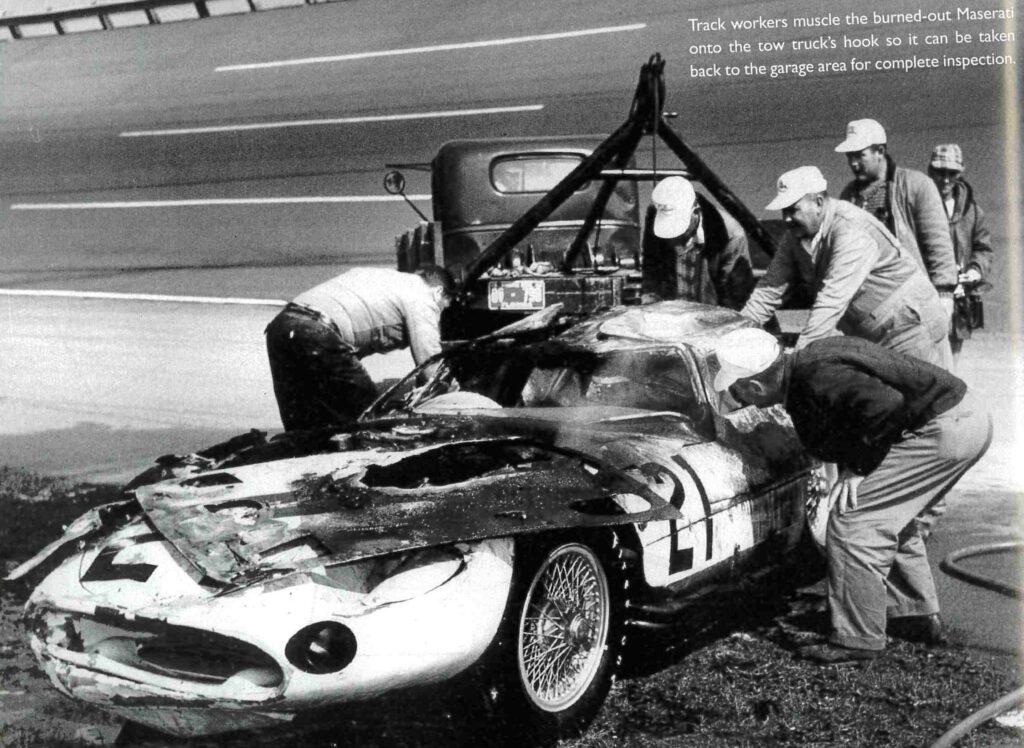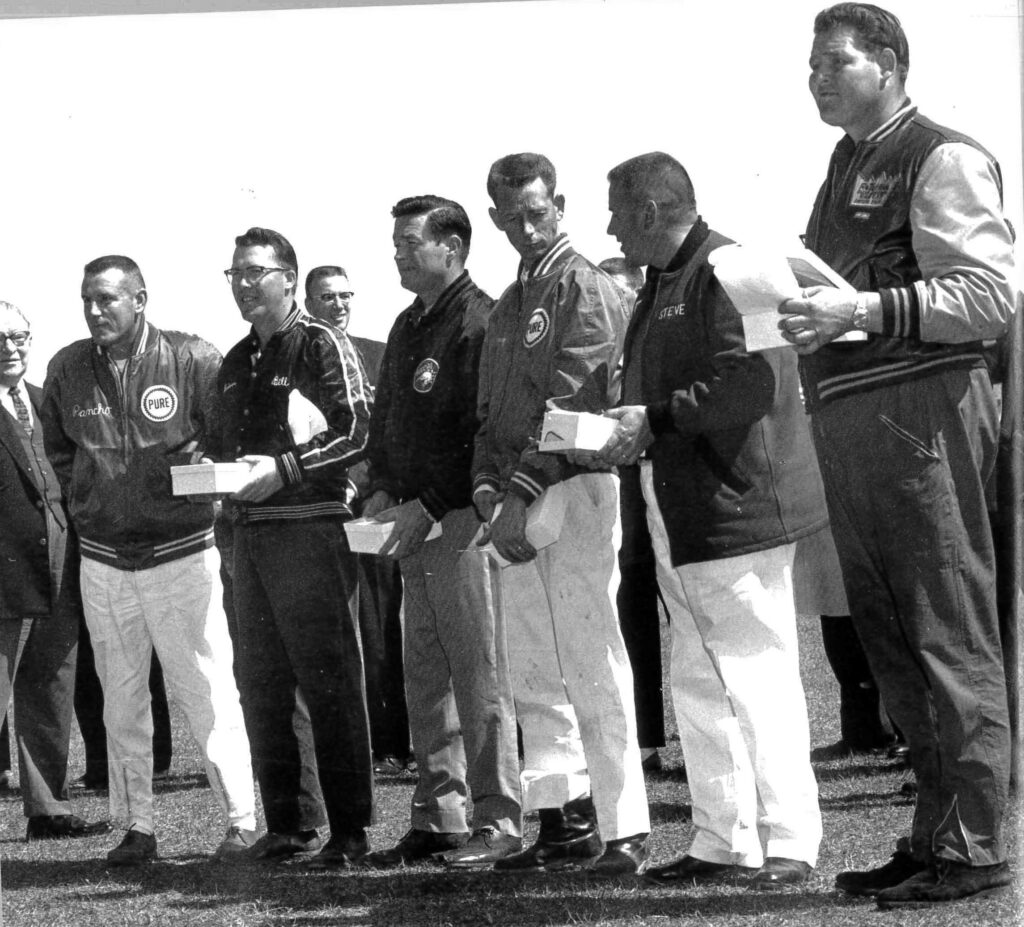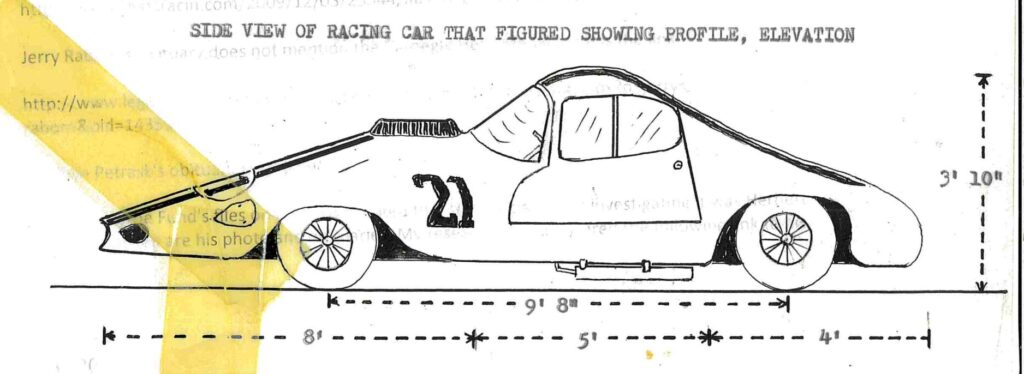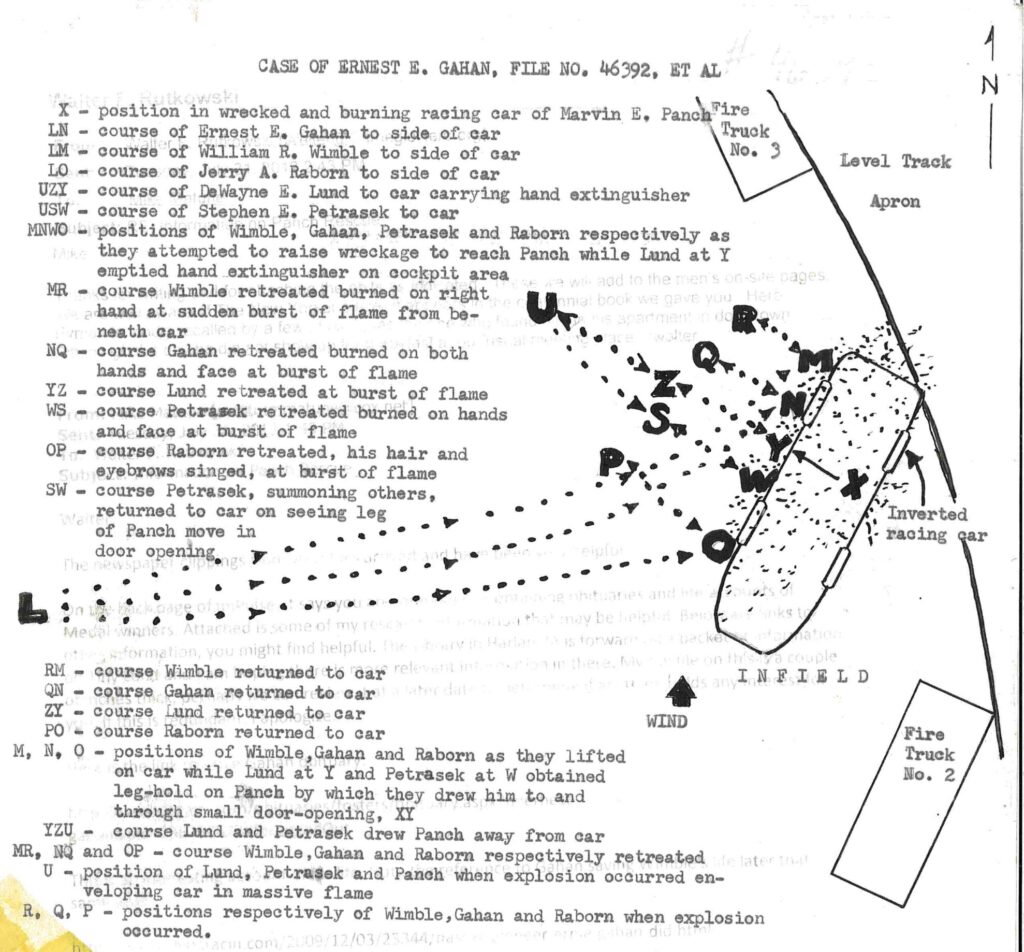
On Valentine’s Day, 62 years ago, Marvin E. Panch, 36, a stock car racing driver, was slated to make a practice run at the speedway in Daytona Beach, Florida, in an attempt to break the closed course speed record.
According to a 2013 Vintage Racecar article written by M.M. Matune, Jr., Panch had an “uneasy feeling” before and on the day of the practice run. The vehicle he was driving was a Maserati Tipo 151 equipped with a Ford engine. Maserati’s distributors felt that the Ford engine’s higher torque would give it an edge, despite its reduced horsepower and higher weight. Another driver, who had driven the Tipo 151 previously, found the car’s road manners troubling; feeling that the increased torque upset the handling.
After calling his wife for his flameproof coveralls, Panch took the Maserati-Ford out on the morning session and clocked speeds just above 163 mph. Feeling more comfortable with its handling, Panch attempted to fulfill the intended purpose of the modified car and break the record.
Panch drove the car twice around the track, approaching speeds of 200 mph, when he entered the southeast curve. Things began to unravel when the Maserati-Ford went out of control, struck the outside guardrail, and flipped over onto its roof.
The car rolled over several times down the banked track and eventually settled upside down in the infield. Gusts of flames appeared in the cockpit. Panch only sustained minor injuries from the crash and managed to empty a small fire extinguisher on the flames with little effect. He released himself from his harness where he dropped to the curved roof canopy and squirmed to a partially seated position. The flames continued to burn as Panch attempted without success to open a door, which was slightly unlatched as a result of the accident.

Several people witnessed the accident, including race drivers Ernest E. Gahan, 36, and William R. Wimble, 31, who stood in the infield.
Gahan drove his sedan onto the infield to the fence opposite of the wreck where he and Wimble then climbed over. They ran toward the car as black smoke rose from the wreckage and flames issued several inches from beneath it along its northwest side. The massive flames rising above the wreckage prevented them from seeing Panch in the cockpit.
By that time, fellow race driver DeWayne L. Lund, 33, approached the accident with tire plant division manager Stephen E. Petrasek, 38, and auto mechanic Jerry A. Raborn, 28, along with fire trucks and others who came to help.
Gahan and Wimble ran to the northwest side of the car and attempted in vain to lift it. Raborn scaled the fence and reached the same side of the car. The three men together were able to raise the vehicle only slightly before the flames beneath the car increased and the heat intensified.
Wind drove the smoke and flames as two fire trucks arrived. Two firemen descended from their trucks but did not attempt to help the three men lift the car. One fireman attached a hose and directed a feeble stream of water on one end of the car with very little effect. The flames around Panch had ignited his coveralls by the time Petrasek and Lund arrived in a station wagon.
Lund ran to the same side of the three men toward the cars northeast end and began to discharge a fire extinguisher around Panch, who was surrounded by flickering flames two to three feet in height. Petrasek and a racing steward who arrived at the scene ran to the other end of Lund to grasp the car and help Gahan, Wimble, and Raborn.
A sudden outburst of flames, ignited by leaking gasoline, then shot upward from the bottom and inflicted burns on all the men but Lund and the steward. The five men released their holds and retreated with Lund. It was then that Petrasek noticed movement at the door opening.
Panch, in what he felt may be his final moments, said his personal goodbyes and prepared to take a deep breath.
Petrasek could see Panch inside and shouted, “He’s still alive! We’ve got to get him out of there!”
Flames continued upward 5 to 6 feet in scattered gusts from the underside of the car and burned over the uppermost side of the vehicle, including the tires.

Despite the intense heat and surging flames, the five men reassembled to their positions around the car. As the others regained hold of the burning vehicle, Lund directed the extinguisher through the door opening and then helped lift the car. Panch managed to work the door farther open as the other men raised the northwest side of the car and thrust both his feet through the opening.
Lund and Petrasek then grasped Panch by the legs and drew him from the cockpit. Panch got to his feet with his coveralls enveloped in flames. The steward threw Panch to the ground and rolled him on the nearby grass as Petrasek beat with both hands at the flames on his attire.
The other men then retreated as an explosion soon occurred and the car was completely enveloped in flames which rose as much as 15 feet above it. Both firemen turned their hoses onto the wreckage while others used portable extinguishers, putting out the flames within twenty-five minutes.
The flames on the clothing of Panch were extinguished and he suffered first-, second-, and third-degree burns on his face, neck, and right hand. He was treated by a physician for three weeks and his burns eventually healed completely. Panch would return to racing in NASCAR’s premier series beginning in June 1963.
Both Gahan and Wimble required treatment for burns they suffered to their hands, wrists, and face. They recovered and returned to the track later that day, heavily bandaged. They competed just two weeks after the accident.
Petrasek suffered first- and second-degree burns on both hands and the side of his face. His vision was temporarily impaired in one eye and he had torn arm muscles from the strain of lifting the car. He recovered from those injuries and his burns healed within ten days.
Raborn avoided serious burns. His eyebrows and hair were singed, and his face was reddened from the heat. He recovered without medical treatment.
Lund avoided any burns but suffered a back sprain from helping lift the car, from which he recovered.
In an incredible turn of events, with Panch sidelined, Lund took on the challenge of racing a little over a week later at the Daytona 500 in his place. Lund would stay competitive with the leaders of the race until the end when he challenged for the lead in the late stages. Lund crossed the finish line first with, ‘fuel to spare’ writes Matune, and even took a victory lap.
The five men who performed the heroic act were awarded the Carnegie Medal in November 1963, and some members of the rescue quintet wrote letters to the commission.
“Hope I can live up to such recognition,” wrote Petrasek. “It is, indeed, a feeling that is indescribable to know our team effort was a success in saving our associate, Marvin Panch, from certain death.”
Wimble’s letter shared similar sentiments, saying, “I hope that my conduct may always be in keeping with ownership of the medal.”
The five heroes stood with Panch at the medal ceremony.
All six men involved in the incident have since passed away.
Unfortunately, Lund died at 46 years old in a six-car accident at the Talladega 500 Grand National stock car race on Aug. 17, 1975. He initially survived the crash, but died fewer than 10 minutes later when he reached an infield hospital. He was remembered fondly and inducted into the Motorsport Hall of Fame in 1994.

Stephen Petrasek died Sep. 15, 2007, in Akron, Ohio, at 82 years old. During his racing career, he was the recipient of numerous awards, including NASCAR Sportsman of the Year in 1963, the Buddy Shuman Award, and the John Naughton Award. He then managed agricultural tire design development and engineering for Firestone worldwide, and was selected as a delegate to set world standards on tires and rims. He was an avid outdoorsman who enjoyed fishing, boating, and big game hunting in the western U.S.
Gahan died at his home in Berwick, Maine, on Nov. 27, 2009, at 83 years old. He built all of his own race cars out of his garage and was an independent driver setting records all over the East Coast during his racing days. In 1966, he received the NASCAR National Modified Championship award at Daytona Raceway. After his racing career, Gahan operated a small construction business out of his home in Berwick.
Jerry Raborn died at age 77 in Huntersville, North Carolina, on June 12, 2010. In addition to his career as an auto mechanic, Raborn was a Navy combat veteran of the Korean War on the USS New Jersey, a former employee of Holman and Moody, Inc., and retired as a long-distance truck driver.
Marvin Panch died at the age of 89 on Dec. 31, 2015, at his home near Daytona. In an article written by John Zimmerman in Vintage Racecar, Panch was described as one of NASCAR’s earliest stars and one of the organization’s Top 50 drivers of all time.
Upon reflecting on the incident where his life was saved, Panch said that the day was the worst and best day of his life. The worst because he got into the mess, and the best because he got out of it, thanks to the efforts of five brave men.
William Wimble passed away in Valrico, Florida, on April 24, 2016, at 84 years old. Wimble was a NASCAR driver, but also worked as a dairy farmer and was a principal for bulk-truck transportation and finance companies. Wimble’s friend, Bill Harman, told The Daytona Beach News-Journal in April 2016 that Wimble was one of his boyhood heroes. Harman called Wimble a “gentleman’s gentleman.”
–Griffin Erdely, Communications Assistant

